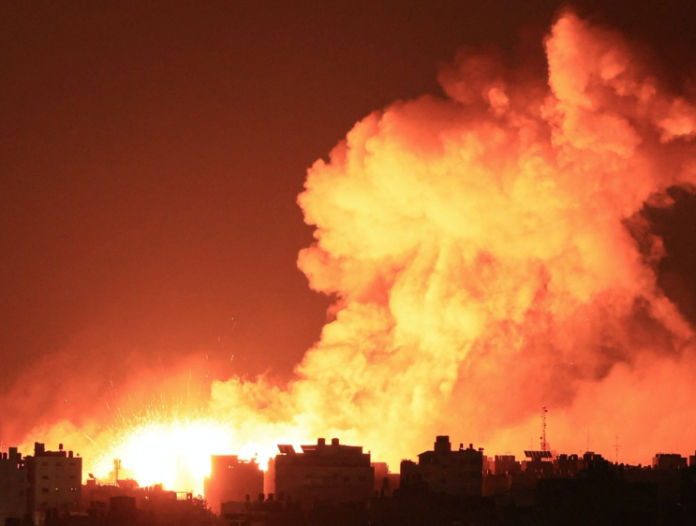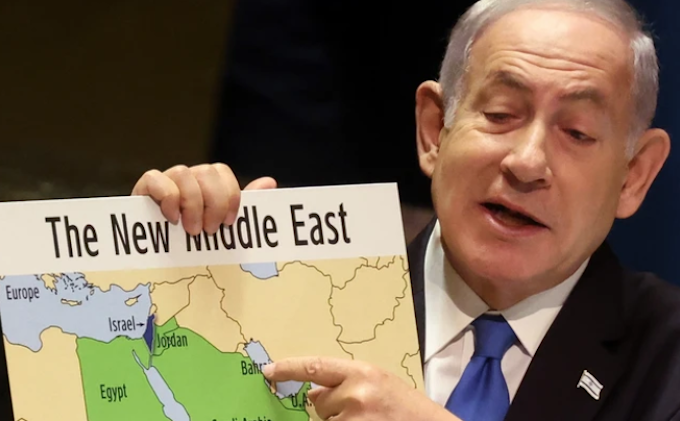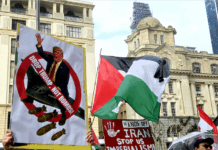
ANALYSIS: By Mouin Rabbani
Almost 50 years to the day after the joint Egyptian-Syrian offensive that launched the 1973 October War, Israel has once again been caught with its pants down. On this occasion its briefs were dangling from its ankles as well.
Operation Al Aqsa Storm, as Hamas named its 7 October 2023 offensive into Israeli territory, represents an even greater Israeli failure.
Extensive and reasonably successful Egyptian and Syrian efforts to conceal their intentions, preparations, and capabilities notwithstanding, Israel in 1973 received multiple warnings about an impending Arab attack from, among others, King Hussein of Jordan, a high-level Egyptian agent, and several of its own intelligence officers.
- READ MORE: Netanyahu shows map of ‘New Middle East’– without Palestine — to UN General Assembly
- Hospitals under threat as Gaza power plant to run out in hours – Al Jazeera live news
- Other Palestine reports
Its primary failure was not ignorance, but the haughty dismissal of knowledge that contradicted preconceptions.
While hubris and complacency have been mainstays in Israel’s dealings with Arab military adversaries, on this occasion it additionally had no information about the impending operation.
This despite its world-leading surveillance and intelligence capabilities, and the reality that the Gaza Strip is not only miniscule in size but also the most intensively and intrusively surveilled territory and population on the planet, and one that has furthermore been under blockade for 17 years.
That Hamas and Islamic Jihad were under these circumstances able to plan and prepare an operation of such scale, scope, and sophistication, a process that will have consumed many months at the least, and will have required extensive communications among leaders, cadres, and operatives, is an astonishing achievement and testament to the legendary resourcefulness of Gaza’s Palestinians.
Launched in plain view
While we can at this point only speculate as to how Hamas managed to prepare and launch this offensive in plain view of Israel, the avoidance or effective encryption of electronic and digital communications will certainly have played an important role.
Similarly, Hamas has in recent years considerably improved its counter-intelligence capabilities to minimise infiltration, an essential feature given the nearly constant flow of Palestinians who transit through Israeli-controlled border crossings and are susceptible to recruitment by Israeli intelligence as conditions for access to health care, employment, and the like.
Rather than serving as Israel’s eyes and ears within the Gaza Strip, it seems likely at least some of these Palestinians conducted reconnaissance for Operation Al Aqsa Storm within Israel.
As for the weaponry used, much of it is either rudimentary or of local manufacture, making ingenious use of available materials such as paragliders, steel from a British ship that sunk off the Gaza coast decades ago to manufacture rocket tubes, and unexploded Israeli ordnance. More advanced capabilities will have been smuggled in, presumably with the assistance of Hizballah in Lebanon, perhaps with the cooperation of sympathetic or corrupt Egyptian border patrols.
The legendary corruption of Israel’s own border crossings with the Gaza Strip may also have played a role.
Committed to fighting the previous war, Israel constructed formidable underground obstacles to prevent Palestinian commandos from infiltrating Israel through their tunnel network. In response, Hamas and Islamic Jihad simply breached the weak points in the barriers surrounding the Gaza Strip, such as wire fences that relied on electronic monitoring rather than more sturdy concrete obstacles (some of which also appear to have been breached).
And a key objective of the initial Palestinian missile barrage, which targeted Israeli military airfields among other objectives, was to paralyze and thus delay Israel’s ability to rapidly respond.
Immediate objectives
Al Aqsa Storm’s immediate objectives were to infiltrate and seize key Israeli security installations, such as the Re’im military base which serves as the headquarters for the Gaza Division; kill or capture a significant number of Israeli soldiers; establish Palestinian territorial control over population centers within Israel’s boundaries for the first time since 1948; and present significantly improved Palestinian capabilities to the Israeli public and security establishment with a massive missile barrage at Israeli cities and the deployment of new infiltration and combat techniques.
While Israeli civilian casualties do not appear to have been an objective as such, it appears that many were killed, and others abducted. Additionally, there are reports of a massacre at a desert party.
In the event, the operation succeeded in nearly all respects, one suspects beyond the wildest expectations of those who planned and executed it. Dozens of Israeli soldiers, including a major general, were spirited into captivity inside the Gaza Strip.
Many more, including senior officers, were killed and wounded, and almost 24 hours after the operation commenced, Palestinian fighters remained ensconced in multiple locations and installations inside Israel.
Images of Israeli bulldozers and missiles deployed against the Israeli police headquarters in Sderot to dislodge Palestinian fighters within it will remain with us for some time, and as with the Egyptian military’s nearly effortless crossing of the Suez Canal in 1973, won’t be erased by subsequent developments.
A more difficult question concerns Hamas’s motives and broader aims. Seen from the movement’s perspective, Israel has simply gone too far, for too long.
Particularly under the stewardship of the Netanyahu government and its predecessor, escalation has been consistent and transformed into a strategy.
Ethnic cleansing
Ethnic cleansing of the Jordan Valley, army-enabled attacks on villages throughout the West Bank by settler auxiliaries, and increasing incursions by prominent Israeli politicians and settler groups into the Haram al-Sharif in Jerusalem’s Old City have reached new heights, and done so in the explicit service of formal annexation.
Indeed, speaking last month to the UN General Assembly, Prime Minister Benjamin Netanyahu displayed a map that showed both the West Bank and Gaza Strip as part of Israel.

In the Gaza Strip, Israel has shown no inclination to lift or significantly relax the blockade, and treats Hamas as a force that can safely be ignored on the grounds that the movement cares about little else than maintaining its rule over the Gaza Strip.
Within Israel’s prisons, the situation of Palestinian detainees has been deteriorating by design. Yet every Israeli escalation has been normalised by Israel’s US and European partners, with each outrage met by little more than paeans to “shared values” and Israel’s “right to defend itself” and, under Washington’s leadership, a focus on an Israeli-Saudi agreement intended to render Palestine and the Palestinians irrelevant.
Within the region, a growing number of Arab states have in practice extended to Greater Israel a halal certificate, at Palestinian expense. Closer to home, Turkey has forced a number of Hamas leaders it previously hosted to leave the country, and Qatar has in recent months reduced the financial support it provides to Gaza in agreement with Israel, on the grounds that Hamas needs to find a more sustainable solution to its financial crisis.
So what is Operation Al Aqsa Storm meant to achieve? It appears that the movement concluded, some time ago, that a repeat of previous confrontations with Israel, such as during the 2021 Unity Intifada, the first that Hamas rather than Israel initiated, would be insufficient to break the logjam, and that only a spectacle on the scale of what we witnessed on October 7 would serve to concentrate minds in Israel and other relevant capitals.
In other words, the main objective would seem to be to render the status quo obsolete and put paid to the Israeli-Egyptian blockade, entirely or at least in its current form. Secondly, Hamas appears determined to free Palestinian prisoners from Israeli jails, and additionally use those it has captured and abducted as leverage in negotiations on other matters, including for example those relating to the Haram al-Sharif.
Insurmountable obstacles
It is highly unlikely that undermining Saudi-Israeli diplomacy formed an important motivation, because the proposed deal faces too many insurmountable obstacles in Washington and Israel, and both Hamas and its allies understand this.
Additionally, if Muhammad bin Salman is determined to proceed with such a deal, there’s no indication he would be deterred by a mound of Palestinian corpses any more than his Arab cohorts who preceded him, and in any case, could consummate any agreement after a decent interval.
This notwithstanding, embarrassing not Riyadh specifically but all regional capitals that maintain formal or informal relations with Israel is an added benefit for Hamas. Particularly so if mass demonstrations in the region in support of the Palestinians serve to remind its governments and the world at large that Palestine remains a live issue.
Hamas and Islamic Jihad can additionally be presumed to hope that their offensive fatally weakens the PA ensconced in Ramallah, thereby creating greater freedom of action for their movements in the West Bank.
The above notwithstanding, the timing of this operation is curious, because conventional wisdom held that Israel’s various adversaries were content with a strategy of managed escalation so as not to interrupt the growing polarisation and dysfunction within the Israeli political arena.
That Hamas nevertheless chose an unprecedented offensive at this moment may have been related to matters of operational security and fears of exposure, or an assessment that this was an opportune moment with Israel having prioritised sadism in the West Bank and reinforcement of its border with Lebanon, or indeed a revised assessment that exposing the colossal failure of Israel’s extremists and security establishment is the best way to weaken them.
It is inconceivable that Hamas would have embarked on an operation of this scale without also preparing for an unprecedented Israeli response. Together with Islamic Jihad and others, it will probably have prepared for massive Israeli incursions into the Gaza Strip launched for the purpose of significantly degrading their organisations and infrastructure, killing cadres and assassinating leaders it can locate, and leaving a massive trail of death and destruction.
Last stand thinking
Better a last stand than a slow death, the thinking apparently goes, particularly if that stand gives a renewed lease on life. Israel will presumably also conduct a massive sweep throughout the West Bank, crack down on Palestinians within Israel, and may also seek to abduct or liquidate Hamas leaders based abroad.
It’s a scenario based on the reasonable assumption that Israel remains unprepared to resume direct control of the entire territory for a protracted period of time. In other words, and as with previous assaults on the Gaza Strip, Israel’s objective may ultimately be to restore a version of the status quo that produced the present crisis.
Inflicting significant casualties in close-quarter combat, as the Palestinians succeeded in doing in 2014, could reduce the length and intensity of such incursions. The Palestinian organisations presumably know better than to believe that holding dozens of Israeli prisoners will provide them with a measure of protection from the authors of the Hannibal Doctrine, which considers a dead Israeli soldier preferable to a captive one.
It is an issue that can at most be used for psychological warfare.
A key question is whether Gaza’s militants will confront Israel only with their existing preparations, or whether Operation Al Aqsa Storm is part of a broader initiative by the self-styled Axis of Resistance, in which Hezbollah and perhaps others will join the fray if Israel crosses certain red lines to relieve the pressure on the Gaza Strip.
If Israel follows through on its demands of mass evacuations of densely populated Palestinian neighborhoods and proceeds with intensive carpet bombing to flatten them, causing mass casualties in the process, we may soon find out.
Mouin Rabbani has published and commented widely on Palestinian affairs, the Israeli-Palestinian conflict, and the contemporary Middle East. He was previously senior analyst Middle East and special advisor on Israel-Palestine with the International Crisis Group, and head of political affairs with the Office of the United Nations Special Envoy for Syria. He is co-editor of Jadaliyya Ezine.













































